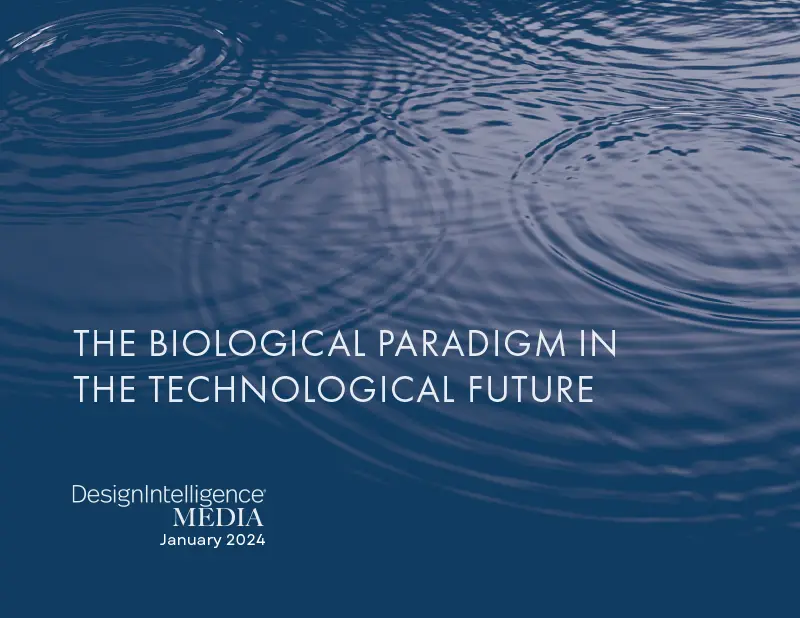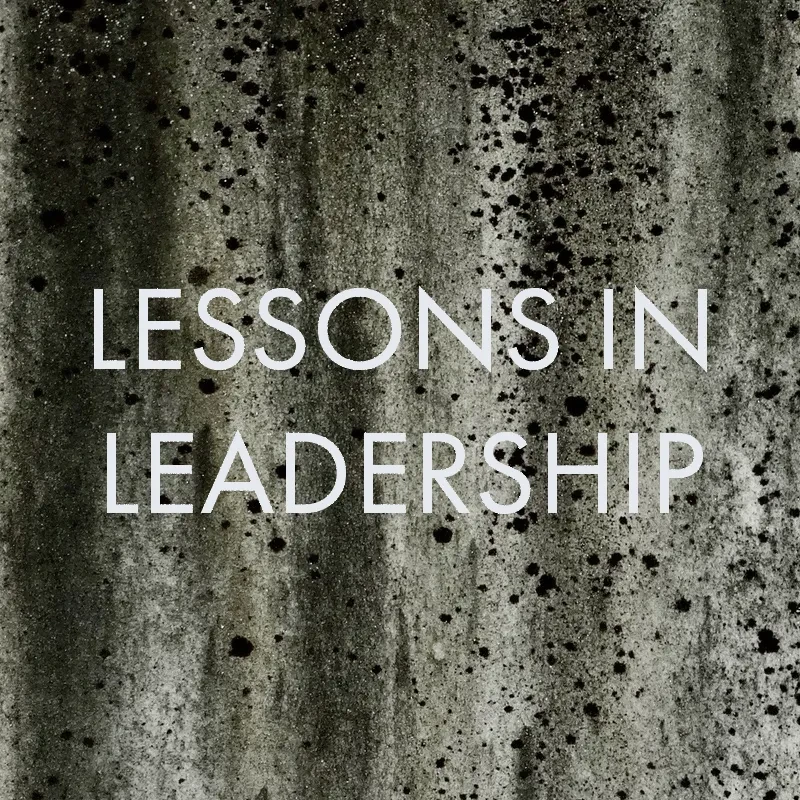
The Biological Paradigm in the Technological Future
DeeDee Birch
Sustainable Design Consultant
and Writer
January 24, 2024
How artificial intelligence, immersive technologies and nature-based design can drive human-centered solutions.
Artificial intelligence and immersive technologies hold enormous potential to help practitioners design buildings that work in symbiosis with the natural world, mitigate the climate crisis and better serve building occupants, particularly when they support the application of nature-based design. These design methodologies — biophilic design and biomimicry — are inherently human-centered design, and their ability to concurrently address the climate crisis and human health is unparalleled. As architect Michael Pawlyn stresses in his text, “Biomimicry in Architecture,” “The biological paradigm, translated into architecture, means putting people at the center.”1 While it will demand that design practitioners embrace new roles in the development of the built environment, leveraging artificial intelligence and immersive technology to expand the ways in which we can apply nature-based design will result in a profoundly regenerative world.
Designing for Multiple Human-Centered Realities
Psychologist Paul Bloom once wrote, “When it comes to nature, we want the real thing; we are uncomfortable with substitutes.”2 But perhaps the greatest danger in the rise of artificial intelligence and immersive technologies is their ability to blur the line between the real and the unreal. In a comprehensive literary review of immersive technologies in architecture and design, A. Prabhakaran et al. describe how these devices create a “reality spectrum” with fully virtual reality isolating the user entirely from their physical environment and mixed (augmented) reality technology combining multiple real and non-real environments into one viewpoint.3 In either scenario, the users’ perception and awareness of their physical world decreases as they fluctuate on their self-imposed reality spectrum. Social ecologist Daniel Stokols conceives of our interior environments as ecosystems, and he argues that the rise of technology — among other social, political and environmental forces — has destabilized the spatial and temporal boundaries of the many ecosystems housed within our built environment.4 Virtual reality will intensify this effect.
The biological paradigm, translated into architecture, means putting people at the center. — Michael Pawlyn
A 2017 national report spearheaded by biophilic design expert Dr. Stephen Kellert and written in collaboration with DJ Case and Associates examined recent changes in the human-nature connection in the United States. The report found “a profound interest-action gap in Americans’ relationship with nature.”5 The authors cite five distinct yet interrelated societal forces as major factors in our growing disconnection from the natural world: the built environment, competing priorities (time, attention, money), declining dependence on the natural world, new technologies (particularly electronic media) and shifting expectations among adults about how much nature is satisfactory.6 The report also underscores that “experiences in nature are deeply social” and recommends emphasizing “regular, recurrent, and routine engagement with nature, the outdoors, and wildlife” in addition to deepening local experiences in nature.7
Virtual reality technology may further disintegrate an already tenuous human-nature connection and drive us further from one another. The Apple Vision Pro virtual reality headset is set to hit the U.S. consumer market in 2024, which will make virtual reality even more ubiquitous. In its release film, Apple boasts of the Vision Pro’s spatial audio system that makes sound feel “like it’s coming from the world around you” and goggles that contain more pixels than a 4K television screen in each eye, “giving you jaw-dropping, lifelike clarity.”8 The features replicate the experience of being in the physical world with astounding accuracy without actually forcing a person to engage with the world at all. If one can pull on a headset and visit the Grand Canyon in the blink of an eye and see it in three dimensions with lifelike clarity, the motivation to travel there in person logically decreases.

With an uptick in virtual reality usage comes concerns about the health impacts of such devices. A. Prabhakaran et al. cite health concerns ranging from unnatural postural and immersion injuries to eye strain, addiction and psychomotor performance shifts.9 This is in large part because virtual reality has significant multisensory limitations. In its current state, virtual reality relies too heavily on visual and auditory inputs; it deprives users of sensory information that is found in nature and foundational in biophilic design. Terrapin Bright Green’s 14 Patterns of Biophilic Design integrate olfactory, gustatory, haptic and stochastic connections with nature into their framework as a means of improving human health outcomes. Furthermore, people employ embodied cognition when navigating through the built environment, meaning we understand our world through the sensory information we gain from occupying a body in space. Every physical place we encounter triggers a multitude of emotions, biochemical reactions and conscious and unconscious thoughts that shape our behavior. Virtual reality offers us only a fraction of our typical sensory experience. In such contexts, we must ask ourselves: How much will our brains and bodies believe?
Multisensory experiences run parallel to the culture-place paradigm that defines biophilic design. Biophilic buildings reflect and embody the climatic conditions and native materials of a place and the cultural identities of its occupants. Buildings embed us in the world, reinforcing a sense of self that encourages well-being. Immersive technologies threaten this culture-place paradigm by creating a sense of placelessness and rendering our physical world much less grounding and useful.
Yet there are some cases in which the ability to dismantle one’s sense of place is helpful. Virtual reality expands the scope of potential positive solutions for systemically and chronically underserved communities because it is nearly instantaneous and much less expensive than construction in our physical world. A headset transports someone to a new place in a matter of seconds, for a fraction of the cost. Take, for instance, Studio Elsewhere’s Recharge Rooms, which were developed for frontline workers during the height of the COVID-19 pandemic. While the project does not utilize virtual reality headsets, recharge rooms were branded as voice-activated “immersive biophilic private spaces.”10 The designs incorporated expansive digital displays of calming nature scenes paired with various potted plants, lighting, olfactory and auditory conditions.
In such contexts, we must ask ourselves: How much will our brains and bodies believe?
For biophilia aficionados, these spaces are relatively controlled environments that lack robust connections with the actual natural world and a tangible connection to place. There are no operable windows with natural light; no gardens with birds, bugs or butterflies; no way to witness changing weather conditions or seasonal shifts in the landscape; no thermal variations or deeply tactile local materials. But studies have shown that even images of nature produce positive responses in people. These recharge rooms were implemented where they were needed most, serving people in dire need of respite and refuge while occupying spaces that were severely disconnected from nature. These installations stand as some of the most highly effective Band-Aids we’ve ever placed on our built environment because of their accessibility, considered application of digital technologies and immediacy. Virtual reality technology can fuel more innovative solutions such as these, reaching some of the most vulnerable populations with solutions that will improve their well-being instantly, while the logistics of building in the real world— funding, permits, community buy-in — can be addressed properly.
Artificial Intelligence, Biomimicry and Biophilic Design
Biophilic design has the power to return us to the conditions for which evolution prepared us by fostering our innate connection to the natural world through architecture. People have done this successfully for centuries. Now, adding the power of artificial intelligence stands to boost the rate of biophilic buildings around the world by recalling those methods. Nikos Salingaros, a mathematician and theorist whose work on fractals and networks has had an indelible impact on biophilic design, argues that architects and designers up until the Industrial Revolution had unwittingly discerned and constructed healing architecture grounded in biophilia:
“Historical selection driven by countless design choices — a sort of Darwinian process among architects and builders — reveals an unvarying set of configurations that trigger the biophilic effect. Traditional forms and structures evolved precisely in this manner, over time, in architecture and urbanism. The biophilic design of buildings therefore mimics the evolutionary growth and multiplication of natural organisms. The multitude of potential geometrical configurations of healthy design, over succeeding generations, “computes” adaptive solutions that are instinctively healthy and attractive to humans. Geometrical configurations that possess a healing effect represent biophilic design’s genetic material. This information was embedded over millennia into the pre-industrial built environment.”11
Central to biomimicry is a willingness to step outside what is possible.
Before the first and second Industrial Revolutions, buildings were inherently biophilic because we built according to our instincts about what was beautiful and functional in the context of a given climate and culture. Then, industrialization resulted in the abandonment of an evolutionary design process that reflected the living world around us and our place within it. The design and construction of buildings took cues from mass production, machines and standardization. If developed with diverse data sets about the preindustrial built environment, artificial intelligence may help architects and designers relearn the language of healing architecture while taking into account today’s unique climatic and social conditions.
Artificial intelligence allows architects and designers to operate with an unprecedented degree of complexity, which in many ways brings us closer to nature’s complexity. Pawlyn, a proponent and pioneer of biomimetic architecture, acknowledges that “while fascination with nature undoubtedly goes back as long as human existence itself, now we can revisit the advances in biology with the massive advantages of expanding scientific knowledge, previously unimaginable digital design tools and aesthetic sensibilities that are less constrained by stylistic convention.”12 His work examines the intricacies of a camel’s nasal structure as a blueprint for better water-recovery heat exchangers, the microstructure of the iridescent Morpho butterfly as a potential way for glass to color itself without added colorants and whale tubercles as a form for more productive and efficient wind turbines.
Never start with reality: always start by identifying the ideal and compromise as little as necessary. — Michael Pawlyn
Biomimetic architecture borrows nature’s function, not simply its form, and applies those functions to the built environment. It requires that we understand how an organism or ecosystem functions well enough to translate and replicate it on a different scale. Artificial intelligence lends itself to biomimicry because it can “process massive amounts of data, recognize the pattern, and … build large-scale statistical models.”13 All projects stand to benefit from the expertise of biologists and polymaths, but not all have the bandwidth for them. As it advances, artificial intelligence will help architects gain value from biological expertise and alleviate designers of the burden of data collection and processing. AI already has the ability to gather and sort massive amounts of data about our unimaginably biodiverse planet in the blink of an eye. Even AI’s text-to-image capability — which many view as a threat to the architectural profession — will serve as a fountain of biomimetic thinking because of its ability to embrace the avant-garde. Central to biomimicry is a willingness to step outside what is possible. As Pawlyn instructs, “Never start with reality: always start by identifying the ideal and compromise as little as necessary.”14
Footnotes:
1 Michael Pawlyn, Biomimicry in Architecture (London: RIBA Publishing, 2011), v.
2 Paul Bloom, How Pleasure Works: The New Science of Why We Like What We Like (New York: W.W. Norton, 2011), 211.
3 A. Prabhakaran, A. Mahamadu, L. Mahdjoubi, “Understanding the challenges of immersive technology use in the architecture and construction industry: A systematic review.” Automation In Construction 137 (May 2022): https://doi.org/10.1016/j.autcon.2022.104228.
4 Daniel Stokols, “The Changing Morphology of Indoor Ecosystems in the Twenty-First Century Driven by Technological, Climatic, and Sociodemographic Forces,” Human Ecology Review 24, no. 2 (2018): 25–40, https://press-files.anu.edu.au/downloads/press/n4974/pdf/stokols_article.pdf.
5 S. Kellert, and DJ Case & Associates, The Nature of Americans: Disconnection and Recommendations for Reconnection, National Report (2023), https://natureofamericans.org/.
6 Kellert and DJ Case & Associates. The Nature of Americans.
7 Kellert and DJ Case & Associates. The Nature of Americans.
8 Apple Vision Pro film, https://www.apple.com/apple-vision-pro/?afid=p238%7CQARJMhwV-dc_mtid_%5Btracker_id%5D_pcrid_77790654446760_pgrid_1244648461539090_&cid=wwa-us-kwbi-VisionPro-slid---productid--Brand-Avalanche-announceBrand-. Accessed November 22, 2023.
9 Prabhakaran, Mahamadu, Mahdjoubi, “Understanding the challenges of immersive.”
10 https://www.studioelsewhere.co/recharge-rooms
11 Nikos A. Salingaros, Biophilia and Healing Environments: Healthy Principles for Designing the Built World (New York: Terrapin Bright Green, LLC, 2015).
12 Pawlyn, Biomimicry in Architecture, v.
13 S.K. Baduge, S. Thilakarathna, J. Perera, M. Arashpour, P. Sharafi, B. Teodosio, A. Shringi, and P. Mendis, “Artificial intelligence and smart vision for building and construction 4.0: Machine and deep learning methods and applications,” in Automation In Construction 141 (September 2022), https://doi.org/10.1016/j.autcon.2022.104440.
14 Pawlyn, Biomimicry in Architecture, 144.
DeeDee Birch, LFA, is an avid writer, researcher, consultant and passionate sustainability advocate with a focus on residential design and the intersections of the sustainability of the built environment and designing for human health. She writes regularly for DesignIntelligence. After earning a BFA in sculpture and BA in English from Boston University in 2018, she completed her Master of Design in Sustainable Design from the Boston Architectural College in 2022. Most recently, DeeDee earned her Living Future Accreditation from the International Living Future Institute and the Healthier Materials & Sustainable Building Certificate from the New School’s Healthy Materials Lab in 2023. She is deeply invested in how creativity can drive sustainability solutions, how complex global systems shape the lives of individuals and how to empower meaningful action in the pursuit of a happier, healthier and more equitable future. See more of her work at www.deedeebirch.com.




